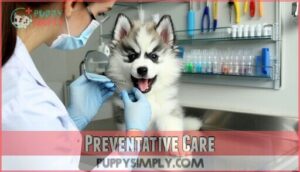This site is supported by our readers. We may earn a commission, at no cost to you, if you purchase through links.
 The average Pomsky lifespan is 12 to 15 years, thanks to their genetics as a mix of Pomeranians and Siberian Huskies.
The average Pomsky lifespan is 12 to 15 years, thanks to their genetics as a mix of Pomeranians and Siberian Huskies.
Proper care plays a big role in keeping these playful pups happy and healthy. A balanced diet, regular exercise, and routine vet visits can make a huge difference.
Watch out for common health issues like hip dysplasia or eye problems, as early detection helps guarantee a longer, healthier life. Think of your Pomsky as a furry little athlete—taking care of their needs keeps their tail wagging for years to come.
Curious about extending that lifespan? Stay tuned for helpful tips!
Table Of Contents
Key Takeaways
- Keep your Pomsky healthy and happy with a balanced diet, regular exercise, and routine vet visits to extend its lifespan to 12–15 years.
- Watch out for common health issues like hip dysplasia, eye problems, and allergies, addressing them with preventative care and early detection.
- Smaller Pomskies tend to live longer, so managing weight and providing proper nutrition makes a big difference in their longevity.
- Create a stress-free environment with consistent routines, plenty of love, and mental stimulation to boost your Pomsky’s quality of life.
Pomsky Lifespan Overview
Pomskies typically live between 12 and 15 years, with proper care making a big difference in their longevity. Their lifespan depends on factors like genetics, size, and overall health.
Proper care, nutrition, and a loving environment are the keys to helping your Pomsky thrive for 12 to 15 joyful years.
Average Lifespan
Pomskies typically live 12 to 15 years, aligning well with common dog lifespan ranges.
Their longevity benefits from genetic factors inherited from both Pomeranians and Huskies. Breed characteristics like size influence lifespan expectancy, as smaller dogs often outlive larger ones.
Health monitoring throughout the aging process helps potential issues are caught early. With proper care, their lifespan mirrors other canine lifespan averages.
Understanding the factors of teacup pomsky care is essential for maximizing the lifespan of these dogs, and requires careful consideration of their genetic factors and proper care.
Influencing Factors
The pomsky lifespan isn’t just nature; nurture plays a big role.
Factors like proper nutrition, owner influence, and the dog’s environment substantially affect longevity.
Think of it as raising a child—you need balance.
Remember these basics:
- Nutrition matters: A quality diet boosts health.
- Owner care: Regular attention is priceless.
- Environment counts: Calm spaces support longer life.
Size and Genetics
Parent genetics play a big part in your pomsky’s size and lifespan.
Smaller pomskies, often closer to their Pomeranian roots, might live slightly longer than larger ones leaning toward Husky traits.
This breed benefits from hybrid vigor, meaning a mix of parent genetics can reduce health risks.
Understanding your pomsky’s genetic traits helps you predict its health, and overall dog longevity.
Factors Affecting Lifespan
Several factors determine how long your Pomsky may live, including diet, exercise, and overall health. By focusing on these areas, you can help your dog enjoy a longer, healthier life.
Diet and Nutrition
A balanced pomsky diet is essential for longevity.
Focus on calorie requirements, portion control, and high-quality dog food rich in nutrients.
Hydration needs shouldn’t be overlooked—fresh water is essential.
Consider supplementation for joint and coat health, but consult your vet first.
Dog nutrition tips emphasize avoiding overfeeding, as obesity affects dog health.
Tailor food types to their age and activity.
Proper dental care, according to a dog lifespan chart, can also substantially extend their life.
Exercise and Activity
Keeping your pup active boosts their lifespan while curbing issues like boredom.
Proper exercise meets your Pomsky’s high energy and mental stimulation needs. Puppies thrive on short play sessions, while seniors prefer gentler activities.
Ideas include:
- Daily walks or hikes
- Fetch in the yard
- Puzzle toys for mental stimulation
- Agility training
- Indoor games during bad weather, which help with mental stimulation and provide high energy release.
Health Conditions
Routine activity builds strength, but health issues lurk beneath even energetic pups.
Watch for breed-specific ailments like hip dysplasia or eye problems. Early detection saves trouble—and veterinary costs.
Genetic predispositions mean some issues are almost baked into their DNA. Use preventative measures to safeguard your pomsky’s health.
| Health Issue | Symptoms | Risk Level | Treatment Options | Preventative Measures |
|---|---|---|---|---|
| Hip Dysplasia | Limping, stiffness | High | Surgery, medication | Weight control, exercise |
| Eye Problems | Cloudy eyes, vision loss | Moderate | Medications, surgery | Regular vet screenings |
| Patellar Luxation | Skipping gait | Moderate | Surgery in severe cases | Healthy weight maintenance |
| Allergies | Scratching, hotspots | Low | Diet changes, medications | Allergy testing, diet care |
| Dental Disease | Bad breath, plaque | High | Tooth cleaning, extractions | Dental care, daily brushing |
Common Health Issues
Pomskies can face several health challenges, including hip dysplasia, eye problems, and patellar luxation. Understanding these common issues helps you take proactive steps to keep your dog healthy and comfortable.
Hip Dysplasia
Hip dysplasia is a frustrating challenge in Pomsky health.
This genetic predisposition affects their hip joints, causing lameness, stiffness, and discomfort.
Symptoms worsen based on severity levels, limiting mobility.
Treatment options include managing weight, physical therapy, or surgery for advanced cases.
Preventative measures like maintaining a healthy weight and regular vet check-ups reduce risks, keeping your Pomsky active and happy.
Eye Problems
Eye problems are common in Pomskies, and they can’t just wear glasses to fix them! Issues like cataracts, corneal dystrophy, and progressive retinal atrophy may lead to vision loss if overlooked.
Stay ahead with regular check-ups. Golden Retrievers, a breed similar in size, are also prone to progressive retinal atrophy.
- Common concerns: Cataracts, retinal atrophy, and corneal dystrophy.
- Warning signs: Cloudy eyes or squinting.
- Glaucoma risks: Requires prompt care.
- Prevention tips: Balanced diet, early detection, and monitoring.
Patellar Luxation
Patellar luxation is a common dog health problem, especially in the Pomsky breed. It’s a kneecap issue that varies by severity grades, from mild to severe.
Puppies may outgrow it, but surgical options might help in serious cases. Conservative management, including weight control and reducing jumping, helps too.
Post-op care often requires therapy to restore mobility. This is crucial for the overall recovery and well-being of the dog.
| Severity Grade | Description | Treatment | Impact |
|---|---|---|---|
| Grade 1 | Kneecap shifts but resets | Conservative management | Minimal discomfort |
| Grade 2 | Random dislocation occurs | Weight management, therapy | Occasional lameness |
| Grade 3 | Permanent, reducible issue | Often surgery needed | Affects mobility substantially |
| Grade 4 | Permanently locked | Surgical correction | Severe mobility challenge |
The treatment varies based on the severity grade, ranging from conservative management for Grade 1 to surgical correction for Grade 4. Understanding the severity grade is essential for determining the best course of action.
Allergies
Skin problems, like allergies, can sneak up and make your Pomsky uncomfortable.
Watch for symptoms like itching, redness, or hair loss. Common allergens include pollen, dust, and certain foods.
Allergy testing helps pinpoint triggers. Treatment options range from special diets to medication.
Stay alert—knowing these dog health tips guarantees your pup’s comfort.
- Allergy Symptoms: Excessive scratching, redness, or irritation.
- Common Allergens: Pollen, dust mites, or specific foods.
- Allergy Testing: Vets can help identify exact triggers.
- Treatment Options: Medications, hypoallergenic diets, or shampoos.
- Dog Health Tips: Regular grooming prevents many skin problems.
Living With a Pomsky
Living with a Pomsky requires patience and consistent effort to meet their needs. These intelligent, energetic dogs thrive in well-structured homes with proper training and socialization.
Patience and effort create a happy, well-trained Pomsky, thriving in a loving, structured home filled with care and attention.
Training and Socialization
Start training your Pomsky early with positive reinforcement and crate training to build good habits.
Early socialization is key to managing the Pomsky temperament and avoiding behavior problems like excessive barking.
Leash training is essential, as Pomskies are energetic. Consistency and short, fun dog training tips help them learn.
A well-socialized Pomsky becomes obedient and confident, creating a balanced companion.
Pomskies, like Pomchis, can suffer from separation and anxiety, which affects their overall well-being and requires proper care.
Living Situation
Pomskies adapt well to apartments if you meet their exercise needs, but a fenced yard is ideal for energetic play.
Consider climate; their double coat suits cooler weather.
Excessive barking can affect noise levels, so train early, and space requirements matter—compact homes work, but they need room to roam.
These factors impact pomsky lifespan by supporting mental and physical health.
Family Dynamics
Pomskies adapt well to families, but their temperament and activity level need matching with your lifestyle.
They’re family-friendly but require early socialization for children interaction and household integration.
Here’s how to align:
- Teach kids to respect pets.
- Schedule active playtime for compatibility.
- Make a family commitment to training.
- Adjust routines for this energetic yet loving companion.
Caring for a Pomsky
Taking care of a Pomsky means staying on top of their health with regular vet visits and preventive care.
By addressing potential issues early, you can help them lead a healthier, longer life.
Regular Veterinary Check-ups
Regular health checkups are key to your Pomsky’s lifespan. Early detection of dog health problems during visits lets your veterinarian take timely action.
Follow vaccination schedules, monitor dental hygiene, and manage parasite control to prevent issues. Routine care guarantees preventative measures are in place, keeping your dog healthy and happy.
A little effort here goes a long way in dog lifespan factors. To prepare, owners can research Pomsky vet products before the visit, ensuring they are well-informed about preventative measures.
Preventative Care
Preventive healthcare boosts your Pomsky’s lifespan. Staying on top of their needs helps avoid common dog health problems.
Focus on:
- Vaccination schedules to shield against illnesses.
Knowing the appropriate vaccination timelines is essential for your Pomsky.
- Parasite control to keep ticks and fleas away.
- Dental hygiene, brushing regularly to prevent decay.
- Grooming needs for a healthy coat.
- Early detection through regular checks to address dog lifespan factors early.
Managing Health Issues
Managing health issues starts with recognizing symptoms early.
Keep an eye on common conditions like hip dysplasia or allergies, especially with genetic predisposition.
Use preventative measures like regular checkups to catch problems fast.
Explore treatment options and dietary adjustments when needed.
Pomsky hip dysplasia can be addressed with specialized products.
Address puppy health issues immediately, as early care influences their lifespan.
Proactive handling of dog health factors guarantees long-term canine wellness.
Maximizing Pomsky Lifespan
You can help your Pomsky live a longer, healthier life with proper care and attention. Focus on spaying or neutering, managing stress, and creating a safe, nurturing environment.
Spaying and Neutering
For many Pomsky owners, spaying and neutering isn’t just a choice—it’s about lifespan and quality of life.
By addressing hormonal impact and cancer prevention, these procedures reduce health issues and behavioral changes like aggression.
The recovery process is manageable, typically under 10 days.
Consult your vet to weigh ethical considerations and dog health factors while ensuring a happier, healthier companion.
Stress Management
A Pomsky’s life expectancy improves when stress is minimized.
Use these strategies to reduce anxiety:
- Stick to routines—dogs thrive on predictability for a better quality of life.
- Try calming techniques like soothing music or dog-safe essential oils.
- Enrich their environment with toys or puzzles to prevent boredom.
Owner wellbeing affects your Pomsky too—stay calm to keep your furry friend stress-free.
Providing a Healthy Environment
A safe environment boosts your Pomsky’s lifespan.
Keep their space clean—because cleanliness matters—and offer mental stimulation through toys or puzzles.
Regular social interaction helps, too; they thrive on love and attention in a stable, loving home.
Combine this with proper dog care tips like understanding dog exercise needs and dog health considerations, and your Pomsky will flourish.
Frequently Asked Questions (FAQs)
How long do pomsky dogs live?
Pomskies live around 12 to 15 years, with some reaching 18 years if well-cared for.
Their lifespan depends on genetics, size, and health care.
Smaller Pomskies tend to live longer, so proper care matters!
How long do mini pomskies last?
Mini Pomskies usually live around 12 to 15 years, similar to standard Pomskies.
Their lifespan depends on genetics, diet, and care.
With proper attention, you can enjoy years of cuddles and playful energy.
What is the average weight of a Pomsky?
You’re looking at a range of about 20 to 30 pounds for most Pomskies.
Their weight depends on genetics, with smaller ones leaning toward 20 pounds and larger ones nearing 30, sometimes slightly exceeding that.
What is a Pomsky?
A Pomsky is a designer dog breed, mixing the playful Siberian Husky and the small, fluffy Pomeranian.
These energetic, affectionate companions charm with their wolf-like appearance and quirky personalities—perfect for devoted, active owners.
How big do pomskies get?
Imagine carrying a fluffy cloud that weighs 20-30 pounds and stands 10-15 inches tall.
That’s your Pomsky, a small-to-medium-sized dog with wolf-like charm, perfect for cozy spaces or active homes alike.
When does a pomsky mature?
Your Pomsky matures around 12 to 18 months but may still mentally act like a puppy.
Their size solidifies earlier, but emotionally they need time, love, and training to grow into well-mannered, confident companions.
How big do Pomskies get?
Pomskies grow to about 10–15 inches tall and weigh between 20–30 pounds, but sizes can vary.
Some may stay smaller, around toy size, while others might surprise you by approaching medium dog dimensions!
How much is a Pomsky?
Pomsky prices vary widely, typically ranging from $2,000 to $5, Costs depend on factors like breeder reputation, puppy size, coat color, and lineage. Expect higher prices for rare traits or exceptional bloodlines.
Do Pomskies shed?
Every rose has its thorn," and with Pomskies, shedding is the thorn.
They’ve double coats, shedding year-round, but even more during seasonal changes.
Regular brushing controls hair and keeps their stunning coats manageable.
Should I adopt a teacup Pomsky?
Adopting a teacup Pomsky sounds tempting, but consider its health risks.
Their tiny size often leads to serious genetic issues.
If you’re set on one, research reputable breeders and prepare for potential medical challenges.
Conclusion
Want your Pomsky to thrive for 12 to 15 years or more? Focus on their health and happiness every day.
A balanced diet, regular exercise, and timely vet visits are non-negotiables for extending the Pomsky lifespan.
Stay alert to common health issues like hip dysplasia to catch problems early. Treat them like the energetic, loyal companions they are.
With proper care, you’re not just adding years to their life—you’re adding life to their years.
- https://www.akc.org/dog-breeds/pomeranian/
- https://www.petcarerx.com/article/what-is-small-dog-syndrome/1488
- https://www.vetfolio.com/learn/article/canine-artificial-insemination
- https://www.dogsnaturallymagazine.com/treatment-options-for-the-luxating-patella/
- https://www.msdvetmanual.com/endocrine-system/the-thyroid-gland/hypothyroidism-in-animals

















